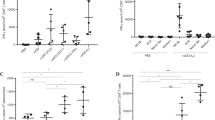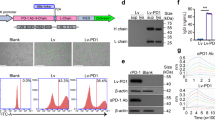Abstract
The current gene transfer technology for single chain (scFv)-based chimeric immune receptor (CIR) has relied on retrovirus and lentivirus vectors which require a long time to obtain sufficient number of transduced cells and stably incorporate into genome. To ameliorate these limitations, we applied RNA electroporation to human peripheral blood lymphocytes (PBLs) activated with anti-CD3 antibody and interleukin-2 (IL-2) for 3 days and assessed that PBL transiently expressing anti-Her-2/neu CIR (CIR-PBL) containing signaling portion of CD28 and CD3ζ could elicit strong cytotoxicity in vitro and antitumor responses in vivo. The CIR-PBL expressed high level of CIR in CD4+, CD8+ and CD56+ cells. Her-2/neu-specific stimulation induced secretion of type-I cytokines including interferon-γ (IFN-γ), IL-8 and granulocyte-macrophage colony-stimulating factor, and IFN-γ secretion was mainly mediated by CD8+ T cells. CIR-PBL specifically killed SKOV3 cell line expressing Her-2/neu. Adoptive transfer of CIR-PBL in SKOV3 xenograft model led to significant inhibition of tumor growth compared with transfer of mock-transduced PBL and showed higher inhibition than those with Herceptin, humanized monoclonal antibody specific for Her-2/neu. These results provided evidence that electroporation of CIR RNA to human PBLs could be used for rapid generation and high number of therapeutic antigen-specific T cells for adoptive immunotherapy.
This is a preview of subscription content, access via your institution
Access options
Subscribe to this journal
Receive 12 print issues and online access
$259.00 per year
only $21.58 per issue
Buy this article
- Purchase on Springer Link
- Instant access to full article PDF
Prices may be subject to local taxes which are calculated during checkout





Similar content being viewed by others
References
Roskrow MA, Suzuki N, Gan Y, Sixbey JW, Ng CY, Kimbrough S et al. Epstein–Barr virus (EBV)-specific cytotoxic T lymphocytes for the treatment of patients with EBV-positive relapsed Hodgkin's disease. Blood 1998; 91: 2925–2934.
Zhou J, Dudley ME, Rosenberg SA, Robbins PF . Selective growth, in vitro and in vivo, of individual T cell clones from tumor-infiltrating lymphocytes obtained from patients with melanoma. J Immunol 2004; 173: 7622–7629.
Dudley ME, Rosenberg SA . Adoptive-cell-transfer therapy for the treatment of patients with cancer. Nat Rev Cancer 2003; 3: 666–675.
Stephan MT, Ponomarev V, Brentjens RJ, Sadelain M . T cell-encoded CD80 and 4-1BBL induce auto- and transcostimulation, resulting in potent tumor rejection. Nat Med 2007; 13: 1440–1449.
Zhao Y, Zheng Z, Robbins PF, Khong HT, Rosenberg SA, Morgan RA . Primary human lymphocytes transduced with NY-ESO-1 antigen-specific TCR genes recognize and kill diverse human tumor cell lines. J Immunol 2005; 174: 4415–4423.
Morgan RA, Dudley ME, Wunderlich JR, Hughes MS, Yang JC, Sherry RM et al. Cancer regression in patients after transfer of genetically engineered lymphocytes. Science 2006; 314: 126–129.
Teng MW, Kershaw MH, Moeller M, Smyth MJ, Darcy PK . Immunotherapy of cancer using systemically delivered gene-modified human T lymphocytes. Hum Gene Ther 2004; 15: 699–708.
Gyobu H, Tsuji T, Suzuki Y, Ohkuri T, Chamoto K, Kuroki M et al. Generation and targeting of human tumor-specific Tc1 and Th1 cells transduced with a lentivirus containing a chimeric immunoglobulin T-cell receptor. Cancer Res 2004; 64: 1490–1495.
Moeller M, Haynes NM, Kershaw MH, Darcy PK . Adoptive transfer of gene-engineered CD4+ helper T cells induces potent primary and secondary tumor rejection. Blood 2005; 106: 2995–3003.
Van Hall T, Wolpert EZ, van Veelen P, Laban S, van der Veer M, Roseboom M et al. Selective cytotoxic T-lymphocyte targeting of tumor immune escape variants. Nat Med 2006; 12: 417–424.
Li S, Yang J, Urban FA, MacGregor JN, Hughes DPM, Chang AE et al. Genetically engineered T cells expressing a HER2-specific chimeric receptor mediate antigen-specific tumor regression. Cancer Gene Ther 2008; 15: 382–392.
Kevin AM, Matthew GR, Peter LS, David MS, M Jim E, Susan MK et al. Targeting immune effector molecules to human tumor cells through genetic delivery of 5T4-specific scFv fusion proteins. Cancer Gene Ther 2002; 9: 884–896.
Ferber D . Gene therapy: safer and virus-free? Science 2001; 294: 1638.
Hacein-Bey-Abina S, Von Kalle C, Schmidt M, McCormack MP, Wulffraat N, Leboulch P et al. LMO2-associated clonal T cell proliferation in two patients after gene therapy for SCID-X1. Science 2003; 302: 415–419.
Baum C, Kustikova O, Modlich U, Li Z, Fehse B . Mutagenesis and oncogenesis by chromosomal insertion of gene transfer vectors. Hum Gene Ther 2006; 17: 253–263.
Nienhuis AW, Dunbar CE, Sorrentino BP . Genotoxicity of retroviral integration in hematopoietic cells. Mol Ther 2006; 13: 1031–1049.
Zhao Y, Zheng Z, Cohen CJ, Gattinoni L, Palmer DC, Restifo NP et al. High-efficiency transfection of primary human and mouse T lymphocytes using RNA electroporation. Mol Ther 2006; 13: 151–159.
Van Meirvenne S, Straetman L, Heirman C, Dullaers M, De Greef C, Van Tendeloo C et al. Efficient genetic modification of murine dendritic cells by electroporation with mRNA. Cancer Gene Ther 2002; 9: 787–797.
Slamon DJ, Clark GM, Wong SG, Levin WJ, Ullrich A, McGuire WL . Human breast cancer: correlation of relapse and survival with amplification of the HER2-2/neu oncogene. Science 1987; 235: 177–182.
Wülfing P, Borchard J, Buerger H, Heidl S, Zänker KS, Kiesel L et al. HER2-positive circulating tumor cells indicate poor clinical outcome in stage I to III breast cancer patients. Clin Cancer Res 2006; 12: 1715–1720.
Cicenas J, Urban P, Küng W, Vuaroqueaux V, Labuhn M, Wight E et al. Phosphorylation of tyrosine 1248-ERBB2 measured by chemiluminescence-linked immunoassay is an independent predictor of poor prognosis in primary breast cancer patients. Eur J Cancer 2006; 42: 636–645.
Wiseman SM, Makretsov N, Nielsen TO, Gilks B, Yorida E, Cheang M et al. Coexpression of the type 1 growth factor receptor family members HER-1, HER-2, and HER-3 has a synergistic negative prognostic effect on breast carcinoma survival. Cancer 2005; 103: 1770–1777.
Jackisch C . HER-2-positive metastatic breast cancer: optimizing trastuzumab-based therapy. Oncologist 2006; 11: 34–41.
Hudelist G, Köstler WJ, Czerwenka K, Kubista E, Attems J, Müller R et al. Her-2/neu and EGFR tyrosine kinase activation predict the efficacy of trastuzumab-based therapy in patients with metastatic breast cancer. Int J Cancer 2006; 1: 1126–1134.
Storniolo AM, Pegram MD, Overmoyer B, Silverman P, Peacock NW, Jones SF et al. Phase I dose escalation and pharmacokinetic study of lapatinib in combination with trastuzumab in patients with advanced ErbB2-positive breast cancer. J Clin Oncol 2008; 10: 3317–3323.
Taylor C, Hershman D, Shah N, Suciu-Foca N, Petrylak DP, Taub R et al. Augmented HER-2 specific immunity during treatment with trastuzumab and chemotherapy. Clin Cancer Res 2007; 1: 5133–5143.
Baselga J, Mendelsohn J . Receptor blockade with monoclonal antibodies as anti-cancer therapy. Pharmacol Ther 1994; 64: 127–154.
Lane HA, Beuvink I, Motoyama AB, Daly JM, Neve RM, Hynes NE . ErbB2 potentiates breast tumor proliferation through modulation of p27(Kip1)–Cdk2 complex formation: receptor overexpression does not determine growth dependency. Mol Cell Biol 2000; 20: 3210–3223.
Baselga J . Clinical trials of Herceptin (trastuzumab). Eur J Cancer 2001; 37 (Suppl 1): 18–24.
Slamon DJ, Leyland-Jones B, Shak S, Fuchs H, Paton V, Bajamonde A et al. Use of chemotherapy plus a monoclonal antibody against HER2 for metastatic breast cancer that overexpresses HER2. N Engl J Med 2001; 344: 783–792.
Janssen EM, Lemmens EE, Wolfe T, Christen U, von Herrath MG, Schoenberger SP . CD4+ T cells are required for secondary expansion and memory in CD8+ T lymphocytes. Nature 2003; 421: 852–856.
Marzo AL, Kinnear BF, Lake RA, Frelinger JJ, Collins EJ, Robinson BW et al. Tumor specific CD4+ T cells have a major ‘post-licensing’ role in CTL mediated anti-tumor immunity. J Immunol 2000; 165: 6047–6055.
Bourgeois C, Veiga-Fernandes H, Joret AM, Rocha B, Tanchot C . CD8 lethargy in the absence of CD4 help. Eur J Immunol 2002; 32: 2199–2207.
Sun JC, Bevan MJ . Defective CD8+ T cell memory following acute infection without CD4 T cell help. Science 2003; 300: 339–342.
Chamoto K, Kosaka A, Tsuji T, Matsuzaki J, Sato T, Takeshima T et al. Critical role of the Th1/Tc1 circuit for the generation of tumor specific CTL during tumor eradication in vivo by Th1-cell therapy. Cancer Sci 2003; 94: 924–928.
Shedlock DJ, Shen H . Requirement for CD4 T cell help in generating functional CD8 T cell memory. Science 2003; 300: 337–339.
Willemsen RA, Ronteltap C, Chames P, Debets R, Bolhuis RL . T cell retargeting with MHC class I-restricted antibodies: the CD28 costimulatory domain enhances antigen-specific cytotoxicity and cytokine production. J Immunol 2005; 174: 7853–7858.
Molina MA, Codony-Servat J, Albanell J, Rojo F, Arribas J, Baselga J . Trastuzumab (herceptin), a humanized anti-Her2 receptor monoclonal antibody, inhibits basal and activated Her2 ectodomain cleavage in breast cancer cells. Cancer Res 2001; 61: 4744–4749.
Yakes FM, Chinratanalab W, Ritter CA, King W, Seelig S, Arteaga CL . Herceptin-induced inhibition of phosphatidylinositol-3 kinase and Akt is required for antibody-mediated effects on p27, cyclin D1, and antitumour action. Cancer Res 2002; 62: 4132–4141.
Cooley S, Burns LJ, Repka T, Miller JS . Natural killer cell cytotoxicity of breast cancer targets is enhanced by two distinct mechanisms of antibody-dependent cellular cytotoxicity against LFA-3 and HER2/neu. Exp Hematol 1999; 27: 1533–1541.
Novellino L, Castelli C, Parmiani G . A listing of human tumor antigens recognized by T cells: March 2004 update. Cancer Immunol Immunother 2005; 54: 187–207.
Acknowledgements
We thank Dr Philip K Darcy for kindly providing retroviral vector encoding anti-Her-2/neu CIR. This study was supported by a grant of the Korea Health 21R&D Project, Ministry of Health & Welfare, Republic of Korea (0405-DB01-0104-0006).
Author information
Authors and Affiliations
Corresponding author
Rights and permissions
About this article
Cite this article
Yoon, S., Lee, J., Cho, H. et al. Adoptive immunotherapy using human peripheral blood lymphocytes transferred with RNA encoding Her-2/neu-specific chimeric immune receptor in ovarian cancer xenograft model. Cancer Gene Ther 16, 489–497 (2009). https://doi.org/10.1038/cgt.2008.98
Received:
Revised:
Accepted:
Published:
Issue Date:
DOI: https://doi.org/10.1038/cgt.2008.98
Keywords
This article is cited by
-
CAR-T cell therapy in T-cell malignancies: Is success a low-hanging fruit?
Stem Cell Research & Therapy (2021)
-
Intracellular Delivery of mRNA in Adherent and Suspension Cells by Vapor Nanobubble Photoporation
Nano-Micro Letters (2020)
-
Targeting T cell malignancies using CAR-based immunotherapy: challenges and potential solutions
Journal of Hematology & Oncology (2019)
-
mRNA as novel technology for passive immunotherapy
Cellular and Molecular Life Sciences (2019)
-
Tools for translation: non-viral materials for therapeutic mRNA delivery
Nature Reviews Materials (2017)



